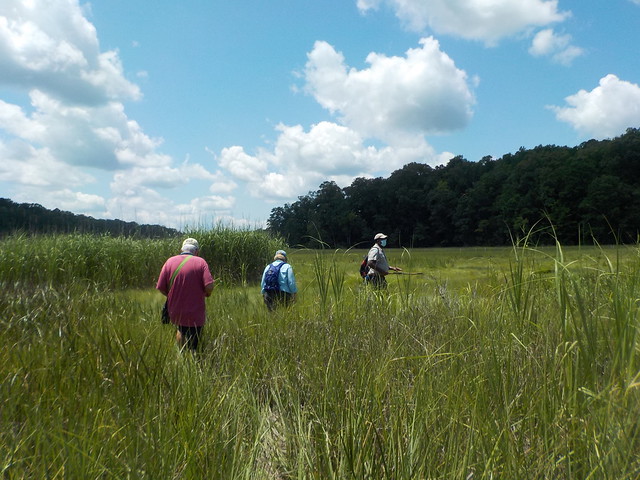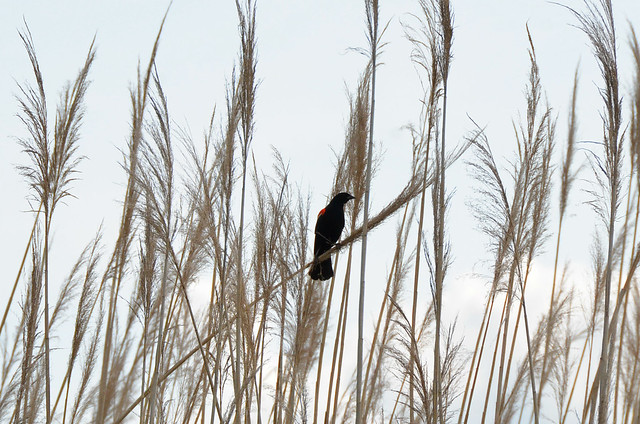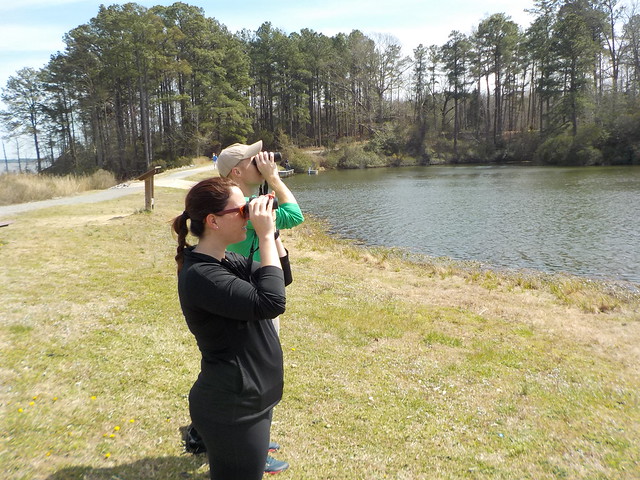Open fires are prohibited throughout the park from midnight to 4 p.m. through April 30 per the 4 p.m. Burning Law. This includes wood and charcoal. Gas is permissible. Campground fires are allowed during the restricted time if a camp host is on duty and signage to that effect is posted in the campground. Failure to observe the 4 p.m. Burning Law can result in a fine. Contact the Park Office for additional information.
Read Our Blogs
Meet the Marsh: Grass & Sky
Published Aug. 20, 2020 | Updated July 16, 2021
The vast wetlands and broad skies of York River State Park are highlights of a rich ecosystem. We know that marshes have an open canopy with no trees found in them from the last article. Let’s discover the plants that grow here and the birds that soar above them.
Grass as far as the eye can see.
Cordgrass Kingdom
Cordgrasses, Spartina, dominate the estuarine marshes. Native Americans and early colonists used them to make rope or cords. Tall cordgrass can reach heights of 6 to 8 feet. It has a feather-like seed head. Short cordgrass grows only about 3 to 4 feet and has a spiked seed head. Salt meadow hay lies flat and gives the marsh the look of a prairie. Early colonists who let their cows graze on this cordgrass complained that the milk tasted briny. All three plants take in the brackish water and excrete the salt through their leaves. Similar plants include switchgrass, salt grass, and black needle rush. Groundsel tree and salt marsh elder are the two shrubs found in and alongside the marshes.
The male red-winged blackbird has a striking color contrast.
On a Wing
Seeds from marsh plants are the food of choice for the resident songbirds. The iconic male red-winged blackbird has a striking red and gold shoulder patch. They will chase away anything away from their nest, even larger birds such as osprey. The marsh wren defends its nest with a song while sharp-tailed sparrows offer no defense at all.
A few small birds are not seed-eaters. Among them is the belted kingfisher. They prefer to dine on any little fish they can find. Sandpipers dig through the mud for worms and tiny crustaceans. These little birds are very skittish when people are present.
You can find great blue herons year-round.
Great blue heron hunt for crabs and fish with careful stealth along the creek and riverbank. They are wading birds similar to the great egret, green heron, and Virginia rail. Great blues are here year-round, while most others waders head south for warmer climates during the winter.
Colder temperatures mean the arrival of waterfowl to the Chesapeake Bay region. Buffleheads, hooded mergansers, and ruddy ducks sometimes make their way into Taskinas Creek. However, the larger rafts of these and other birds are found in the York River near the fringe marshes. Groups of 50 to 200 ruddy and canvasback ducks are common from November to March. Some bald eagles from Canada make their way here as well.
Many beginning and seasoned birders admire bald eagles.
Ospreys arrive in the early spring and compete with our resident eagles for fish. These birds of prey are efficient anglers with a 70% catch rate. Bald eagles are notorious for trying to steal an osprey’s catch. The smaller belted kingfisher avoids competition from the raptors by catching little fish.
Beginning Birding Tips:
- Bird watching in a marsh can be done any time of the day.
- Stealth is the way to see some species.
- Loud and erratic movement scares birds away.
My first photo of a bald eagle was from the Croaker Landing fishing pier. I stood still under the shelter at the end. The bird didn’t see me as a threat. I was surprised at how close it came to me.
Enjoy birding at a Virginia State Park,
As mentioned, some species are seasonal. Osprey lovers and green heron “hunters” should continue to make use of this time before the autumnal equinox. Waterfowl do not make their appearance until November and December. When possible, visit a marsh after a major storm. You never know what may fly in. We have seen such oddities as cattle egrets and sandhill cranes. Be ready for what you expect and expect the unexpected!
What kind of fish do these birds feed on? What mammals make their home in the marsh? Stay tuned for the next article as we’ll discover the creatures and critters of this ecosystem.
York River State Park is located near Williamsburg, Virginia, in James City County. Click here for a Google map. Find more information on York River State Park or call the park office, 757-566-3036.
This is the second in a series of articles on the marshes at York River State Park. The first installment is Meet the Marsh: Definition & Types, the third is Meet the Marsh: Creatures and Critters.
If you have read the article and have a question, please email nancy.heltman@dcr.virginia.gov.
Search for blogs
By Park
Categories
Cabins
Camping
Fishing
History and Culture
Other
Programs and Events
Trails
Volunteers
Water Fun
Archive
2024
2023
2022
2021
2020
2019
2018
2017
2016
2015
2014
2012



















